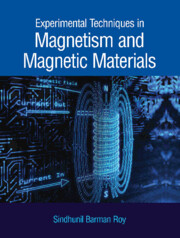Book contents
- Frontmatter
- Dedication
- Contents
- Preface
- I Introduction to Magnetism and Magnetic Materials
- II Basic Phenomenology of Magnetism
- III Experimental Techniques in Magnetism
- Appendix A Magnetic Fields and Their Generation
- Appendix B Units in Magnetism
- Appendix C Demagnetization Field and Demagnetization Factor
- Index
10 - X-ray Scattering
Published online by Cambridge University Press: 27 October 2022
- Frontmatter
- Dedication
- Contents
- Preface
- I Introduction to Magnetism and Magnetic Materials
- II Basic Phenomenology of Magnetism
- III Experimental Techniques in Magnetism
- Appendix A Magnetic Fields and Their Generation
- Appendix B Units in Magnetism
- Appendix C Demagnetization Field and Demagnetization Factor
- Index
Summary
We have seen in the previous chapter that thermal neutrons with their unique combination of wavelength (≈˚A), magnetic moment (≈ μB), and penetration power in materials can be a very sensitive probe to investigate microscopic magnetic properties. Elastic neutron scattering experiments provide information on the magnitudes and direction of the magnetic moment for complex spin arrangements. Inelastic neutron scattering experiments provide information on spin dynamics such as spin waves or magnons, spin fluctuations, crystal-field excitations, etc.
It had been known for quite some time that X-rays being part of the electromagnetic spectrum can have specific interactions with ordered arrangements of spins in magnetic materials. The absorption cross section and the scattering amplitudes of electromagnetic waves are related through the optical theorem [1], hence magnetic effects are also expected to be observed in X-ray scattering. However, that magnetic interaction is very weak, leading to only very small effects, and as a result for many years, X-rays were not considered as a useful probe of magnetism. In the 1970s–80s in a series of elegant pioneering experiments de Bergevin and Brunel [2, 3] and Gibbs and his collaborators [4, 5] demonstrated that X-ray diffraction effects from magnetic materials could be detected experimentally. These important developments along with the relatively easy access to modern synchrotron radiation sources with the capability of probing small samples with a highly collimated and intense X-ray beam, high degree of photon beam polarization, and energy tunability have made magnetic X-ray diffraction studies a complementary and in some cases competitive technique to neutron scattering studies in the study of magnetic materials [6, 7, 8, 9]. These magnetic X-ray diffraction techniques will be discussed below, and the narrative will closely follow the articles by C. Vettier and L. Paolisini [6, 7].
Magnetic and Resonant X-ray Diffraction
In a purely nonrelativistic limit, X-rays interact only with the electronic charges in solids, hence no information is obtained on the spin densities. The first calculation of the amplitude of X-rays elastically scattered by a magnetically ordered solid was carried out by Platzman and Tzoar [10] in 1970 within the framework of the relativistic quantum theory. That calculation predicted that magnetic X-ray scattering could be observed. Within two years De Bergevin and Brunel [2] reported the first experimental observation of such effects in a single-crystal sample of antiferromagnetic NiO.
- Type
- Chapter
- Information
- Experimental Techniques in Magnetism and Magnetic Materials , pp. 237 - 258Publisher: Cambridge University PressPrint publication year: 2023
- 1
- Cited by

